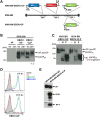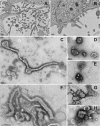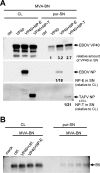Recombinant Modified Vaccinia Virus Ankara Generating Ebola Virus-Like Particles
- PMID: 28331098
- PMCID: PMC5432887
- DOI: 10.1128/JVI.00343-17
Recombinant Modified Vaccinia Virus Ankara Generating Ebola Virus-Like Particles
Abstract
There are currently no approved therapeutics or vaccines to treat or protect against the severe hemorrhagic fever and death caused by Ebola virus (EBOV). Ebola virus-like particles (EBOV VLPs) consisting of the matrix protein VP40, the glycoprotein (GP), and the nucleoprotein (NP) are highly immunogenic and protective in nonhuman primates against Ebola virus disease (EVD). We have constructed a modified vaccinia virus Ankara-Bavarian Nordic (MVA-BN) recombinant coexpressing VP40 and GP of EBOV Mayinga and the NP of Taï Forest virus (TAFV) (MVA-BN-EBOV-VLP) to launch noninfectious EBOV VLPs as a second vaccine modality in the MVA-BN-EBOV-VLP-vaccinated organism. Human cells infected with either MVA-BN-EBOV-VLP or MVA-BN-EBOV-GP showed comparable GP expression levels and transport of complex N-glycosylated GP to the cell surface. Human cells infected with MVA-BN-EBOV-VLP produced large amounts of EBOV VLPs that were decorated with GP spikes but excluded the poxviral membrane protein B5, thus resembling authentic EBOV particles. The heterologous TAFV NP enhanced EBOV VP40-driven VLP formation with efficiency similar to that of the homologous EBOV NP in a transient-expression assay, and both NPs were incorporated into EBOV VLPs. EBOV GP-specific CD8 T cell responses were comparable between MVA-BN-EBOV-VLP- and MVA-BN-EBOV-GP-immunized mice. The levels of EBOV GP-specific neutralizing and binding antibodies, as well as GP-specific IgG1/IgG2a ratios induced by the two constructs, in mice were also similar, raising the question whether the quality rather than the quantity of the GP-specific antibody response might be altered by an EBOV VLP-generating MVA recombinant.IMPORTANCE The recent outbreak of Ebola virus (EBOV), claiming more than 11,000 lives, has underscored the need to advance the development of safe and effective filovirus vaccines. Virus-like particles (VLPs), as well as recombinant viral vectors, have proved to be promising vaccine candidates. Modified vaccinia virus Ankara-Bavarian Nordic (MVA-BN) is a safe and immunogenic vaccine vector with a large capacity to accommodate multiple foreign genes. In this study, we combined the advantages of VLPs and the MVA platform by generating a recombinant MVA-BN-EBOV-VLP that would produce noninfectious EBOV VLPs in the vaccinated individual. Our results show that human cells infected with MVA-BN-EBOV-VLP indeed formed and released EBOV VLPs, thus producing a highly authentic immunogen. MVA-BN-EBOV-VLP efficiently induced EBOV-specific humoral and cellular immune responses in vaccinated mice. These results are the basis for future advancements, e.g., by including antigens from various filoviral species to develop multivalent VLP-producing MVA-based filovirus vaccines.
Keywords: Ebola; MVA; VLP.
Copyright © 2017 American Society for Microbiology.
Figures








References
-
- Kuhn JH, Becker S, Ebihara H, Geisbert TW, Johnson KM, Kawaoka Y, Lipkin WI, Negredo AI, Netesov SV, Nichol ST, Palacios G, Peters CJ, Tenorio A, Volchkov VE, Jahrling PB. 2010. Proposal for a revised taxonomy of the family Filoviridae: classification, names of taxa and viruses, and virus abbreviations. Arch Virol 155:2083–2103. doi: 10.1007/s00705-010-0814-x. - DOI - PMC - PubMed
MeSH terms
Substances
LinkOut - more resources
Full Text Sources
Other Literature Sources
Medical
Research Materials
Miscellaneous

